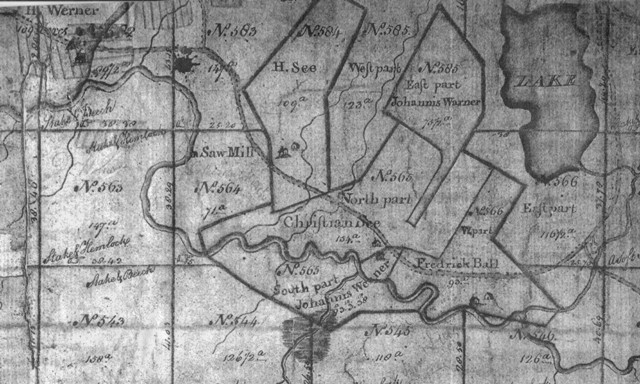Warner's Sawmill
Jump to navigation
Jump to search

- 1765 when the Warner family moved to the Beaver Dam (now Berne) from Schoharie they settled between what is now the hamlet of Berne and East Berne]]. A sawmill was built on the Foxenkill just upstream from the intersection of [[Turner Road with Helderberg Trail. It was operated by both the Warners and the Zehs according to 1787 Van Rensselaer lease records. The Warners and Zehs did not originally lease their land from the Van Rensselaers. Rather, they were squatters, as were all early Berne settlers, on a vast tract of land that had been granted by the Dutch to the Van Rensselaer family in 1629. The VR land in the Hudson Valley was leased long term, but never sold. About the time of the Revolutionary War the VR family became aware that squatters from Schoharie and elsewhere had made themselves at home in the wilderness above the Helderberg Escarpment.
- long before 1787 all five of Mathias Warner's sons were living in what is now the Town of Berne. His younger son, Philip, was 20-years old when he was confirmed at the Beaverdam Reformed Church in 1767. Since he was single and undoubtedly living at home, it is likely that his father, Mathias Warner, moved his family to Beaver Dam by 1765 when the Warner and Zeh sawmill was established.
- 1787 Stephen Van Rensselaer III had William Cockburn survey his land in the Helderbergs. The purpose was to force leases on the squatters who had been living there rent free, some of them for almost half a century, and to mark 160 square acre lots on the vacant land prior to seeking renters. Survey notes for Lot 564, the site of the present day Pine Grove Park residential area, say "This is a Middling good Lot, Well Watered by the foxen Kill on which is a fine Sawmill, with a gang of Saws. The Werners & See's [Zehs] are the Chief proprietors of it. Chiefly Pine & Oak Timber." Werner is the original German spelling of Warner. See is an alternative English spelling of Zeh. Names in italics are the spelling in the original document. Cockburn's 1787 map shows the Warner and Zeh sawmill on the bank of the Foxenkill on the western edge of the 71 acre lot 564. The lot's irregular shape indicates that it was settled by squatters before the survey. H. See lived on the adjoining lot 584 to the east. Between Helderberg Trail and the Foxenkill was the north part of Lot 565 farmed by Christian See. The south part of Lot 565, on the south side of Fox Creek, was the farm of Johannis Werner. He also farmed the east part of Lot 585 which was just west of Warners Lake. The 1787 map does not show the three lots his brother Christopher Warner had on the north side of the Lake. The 1787 survey map shows H. Werner on Lot 581 east part. Cockburn’s survey notes say This land in lot 581 is very poor and lies chiefly on the north side of a very steep hill. It is well watered by the Foxenkill on the north side of which the land is middling good. Henry Warner has got a part of his improvement on it. Beech, maple some elm and fine timber. Just to the east is Lot 582 of which the survey or reported: This is a good lot and is well watered by the Vosenkill Foxenkill. Henry Warner has got a framed house and barn and a fine improvement on this lot. Beech, maple and hemlock timber.
- Sept. 10, 1790 a Van Rensselaer record notes Henry Warner's property leased. John H. Warner his son owns it. Henry Warner was the brother of Christopher and Johannes. This is probably the Henry Warner House reportedly built 1795. Although a Berne Historical Society officer says it was built by a Zeh, the Van Rensselaer lease records and 1787 survey map indicate the house was built prior to 1787 by Henry Warner. Henry, Christopher, and Johannes were three of five sons of Mathias Warner Sr. who was born 1707 in Württemberg, Germany. Mathias’ father, Christopher Warner, was one of hundreds of refugee families from the Palatinate area of Germany brought over by the English in 1710. They were to be resettled in the wilderness on the frontier in upstate New York to serve as a buffer between the English settlements along the Hudson, and the French and Indians to the west and in Canada. But first, to pay back the cost of their transportation and subsistence, they were to endure years of forced labor in a work camp on the Hudson devoted to the production of tar for the British Navy. When this operation failed in 1712, Christopher Warner, along with the Zehs and more than a hundred other families, sought refuge in the Schoharie Valley.
- 1866 Beers map of Berne shows an “F. & S. Mill” (Feed and Sawmill) in the same location. The mill buildings were likely used into the early 20th-Century. Today, the remains of the millpond dam and wooden flume, as well as the foundations of the mill buildings, can still be seen at the site.
On the eastern part of the sawmill lot was the Zeh and Warner families burying ground with the earliest known burial 1777. The Zehs and Warners were instrumental in the 1790 incorporation of the Lutheran Church in Beaver Dam. July 1797 the church leased lot 564 where the sawmill and burying ground were located. Using planks sawed at the mill, a frame church was constructed near the burying ground, now known as the Pine Grove Cemetery.